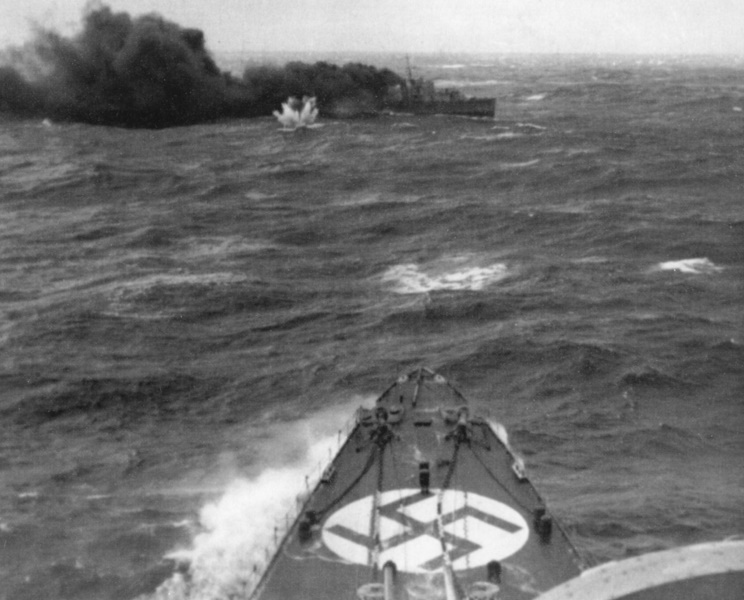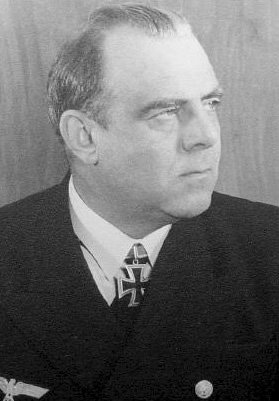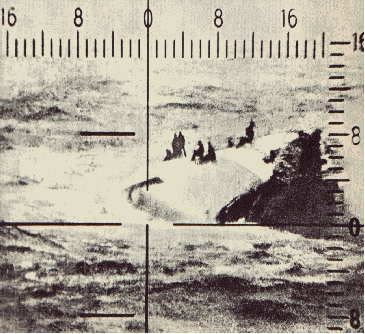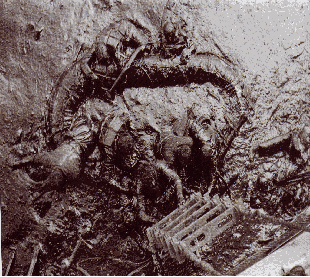Monday 8 April 1940
 |
| Famous shot taken from the Admiral Hipper of the HMS Glowworm turning to ram the Admiral Hipper off of Norway, 8 April 1940. |
Battle of the Atlantic: Shortly after midnight on 8 April 1940, Kriegsmarine Marine Group 3 departs from Wilhelmshaven for Bergen. It includes cruisers Königsberg & Köln, transport Karl Peters, minelayer Bremse & 5 torpedo-boats carrying 1900 troops.
At dawn, Marine Group 4 and Marine Group 6 depart from Cuxhaven. They are carrying 1250 troops for the south coast of Norway.
Marine Group 5 departs Wilhelmshaven Swinemünde for Oslo. It includes cruisers Blücher, Lützow and Emden, 8 minesweepers & 3 torpedo-boats carrying 2000 troops.
Operation Wilfred, the British mining of Norwegian territorial waters, proceeds southwest of Narvik and northwest of Bodo at 05:00. Both British and French ships take part, and the entire operation only takes an hour. HMS Esk, Icarus, Impulsive & Ivanhoe lay mines in the Vestfjord, gateway to Narvik. The British government announces the mining operation publicly at 17:15 and also announces where the mines are being placed: Vest Fjord, Bud and Stadtland.
The British tell the Allies of Operation Wilfred at 06:00. They justify it as necessary to prevent passage of ships "carrying war contraband." The Norwegian government immediately protests to the British about their minelaying in Norwegian territorial waters.
 |
| Captain Hellmuth Heye, in command of the Admiral Hipper. |
At first light, destroyer HMS Glowworm, separated from the mining operation due to having had to search for a man overboard, calls off its search for the missing man. It then happens upon the German destroyers Bernd von Arnim (Z11) and Hans Ludemann (Z18), part of Marine Group 1 headed for Trondheim. Heavy cruiser Admiral Hipper, 14,000 tons, accompanied by four destroyers, is heading for Trondheim. Glowworm, in one of those epics of the Royal Navy, battles the cruiser and its 8-inch shells. It misses with four torpedoes, then makes a smoke screen. Then, instead of running away, he turns and rams the cruiser before being sunk, inflicting major damage. Some 130 feet of her armoured belt is ripped away, with 500 tons of seawater entering.
There are 118 dead, with 31 crew being taken prisoner on the Admiral Hipper. Captain Heye spends an hour rescuing them. Rooper himself was found and was being pulled up on a rope when he lost his grip and fell back into the water, never to be seen again.
 |
| Captain Roope, V.C. |
Captain Gerard Broadmead Roope earns the first Victoria Cross of World War II, but only after the war ends and the log of the Admiral Hipper is read by British authorities. He is killed in the engagement after helping survivors put on life jackets. Captain Hellmuth Heye of the Admiral Hipper supports the award by writing to the British authorities via the Red Cross giving a statement of Commander Roope’s courage and actually recommending the V.C. for the dead captain.
Roope manages to radio his position and situation before sinking to the HMS Renown, in charge of the Home Fleet. However, it is too late for the Home Fleet, which has sailed in the wrong direction, to intervene.
HMS Ursula, Triad and Sterlet leave to patrol the Skagerrak. Placement of the British submarine fleet around Norway by Admiral Horton begins to bear fruit. Kriegsmarine transport Rio de Janeiro, on her way to Bergen, is sunk in the Skagerrak at 12:00 by the Polish submarine Orzeł under British command. This sends fully armed German troops into the water. About 150 are drowned, another 150 are pulled out of the water by Norwegian fishing boats. They freely tell their saviours that they were headed to Bergen. The Norwegians, thus alerted, do not inform the Admiralty.
German tanker Posidonia is sunk by Royal Navy submarine HMS Trident.
Convoy OA 125 departs from Southend, Convoy OB 125 departs from Liverpool.
European Air Operations: Today is the first sortie by German long-range Focke Wulf FW 200 Condor four-engine reconnaissance bombers over the North Sea.
The Luftwaffe raids the British Home Fleet base at Scapa Flow and causes some slight damage on land. The British fleet is largely out to sea and suffers no damage. Two of the planes are shot down by Coastal Command, while a third is badly damaged.
RAF: The Civilian Repair Organisation (CRO) comes into being. It is intended to repair damaged RAF planes using civilian resources.
Australian sloop HMAS Parramatta (Lt. Commander Jefferson H. Walker) is commissioned.
Sweden: The government begins a limited military mobilization.
Future History: John Havlicek is born in Martins Ferry, Ohio. He becomes a legendary player with the Boston Celtics basketball team in the 1960s and 1970s.
 |
| Gun camera shot of the remnants of the HMS Glowworm. |
April 1940
April 1, 1940: Weserubung is a GoApril 2, 1940: British Subs On Alert
April 3, 1940: Churchill Consolidates Power
April 4, 1940: Missed the Bus
April 5, 1940: Mig-1 First Flight
April 6, 1940: Troops Sailing to Norway
April 7, 1940: Fleets At Sea
April 8, 1940: HMS Glowworm and Admiral Hipper
April 9, 1940: Invasion of Norway
April 10, 1940: First Battle of Narvik
April 11, 1940: Britain Takes the Faroes
April 12, 1940: Germans Consolidate in Norway
April 13, 1940: 2d Battle of Narvik
April 14, 1940: Battle of Dombås
April 15, 1940: British in Norway
April 16, 1940: Germans Cut Norway in Half
April 17, 1940: Trondheim the Target
April 18, 1940: Norway Declares War
April 19, 1940: Dombås Battle Ends
April 20, 1940: Germans Advancing in Norway
April 21, 1940: First US Military Casualty
April 22, 1940: First British Military Contact with Germans
April 23, 1940: British Retreating in Norway
April 24, 1940: British Bombard Narvik
April 25, 1940: Norwegian Air Battles
April 26, 1940: Norwegian Gold
April 27, 1940: Allies to Evacuate Norway
April 28, 1940: Prepared Piano
April 29, 1940: British at Bodo
April 30, 1940: Clacton-on-Sea Heinkel
2016

No comments:
Post a Comment